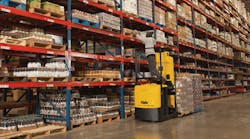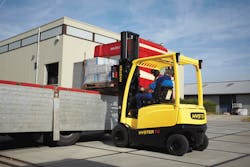National Forklift Safety Day, sponsored by the Industrial Truck Association, served as a focal point for manufacturers to highlight the safe use of forklifts and the importance of operator training. The day provided an opportunity for the industry to educate customers, policymakers and the administration on forklift operating safety practices.
While National Forklift Safety Day created greater awareness of safe practices and encouraged safer behavior, we have to ensure that the safety message is shared 365 days a year.
In this Q&A, Chuck Pascarelli, president of sales and marketing, Americas, for Yale Materials Handling Corp., and Paul Laroia, vice president of aftermarket for Hyster Co., answer my questions about Forklift Safety. What I learned is that in the case of forklift safety, oftentimes the manufacturers also are the experts.
Sandy Smith, EHS Today (SS): What should a written forklift safety policy or program include?
Paul Laroia, Hyster Co. (PL): Regardless of the type of forklift being used, training, application knowledge and proper truck maintenance are three of the most critical factors in maintaining a safe work environment.
- Training – Companies must ensure operators receive training on the equipment they will be operating; specifically, that they have read and fully comprehend the operator manual and are aware of the warning labels on the truck.
- Application knowledge – To uphold safety, operators must be very familiar with and thoroughly understand the specific application in which they are working.
- Proper truck maintenance – Routine maintenance helps reduce not only the number of needed repairs but also the risk of accidents that could cause injuries.
Operator training is critical to overall lift truck safety as 70 percent of all industrial accidents are operator-induced, according to the National Safety Council. OSHA estimates that effective training may reduce the accident rate by 25-30 percent, and that following training of lift truck operators, there is a 61 percent improvement in operator performance scores.
Chuck Pascarelli, Yale Materials Handling Corp. (CP): Per OSHA regulations, every lift truck safety program must include operator training, evaluation and certification. It’s critical that operators understand the fundamentals of not only the lift truck equipment they will be operating, but also their specific operating environment.
At Yale, we [offer a] Handle with Care Operator Training Program [that] covers all five lift truck classes, and contains everything needed to conduct the classroom component of an OSHA-compliant operator training program including:
- Instructor guide
- Class-specific tests
- Operating manual
- Course completion certificates
- Authorized wallet cards
SS: What are the key elements of a forklift safety training program for operators? Are there aspects of training that are overlooked? What does OSHA require?
CP: Key elements of a lift truck safety training program, as required by OSHA, encompass specific aspects of the lift truck including warnings, capacity, stability and controls, as well as workplace topics such as surface conditions, pedestrian traffic, hazardous locations and load analysis.
Infographic: Forklift Safety: Tips on Operator and Employee Training
PL: At a minimum, forklift training should address the following major areas:
- General operating fundamentals associated with most forklifts, including fuel and battery handling.
- Focused areas associated with the operation of specific types of trucks.
- General workplace hazards, such as lighting and surface conditions.
- Particular workplace hazards, such as ramps, docks and aisle widths.
- Factors that can affect the stability of a forklift, such as load shape, speed of travel, tire condition and driving behaviors.
At Hyster Co., we believe that the knowledge and skill of each operator is essential to the safety of everyone involved, therefore we offer [a] Best-In-Class Operator Training Program that includes everything needed to conduct the classroom component of an OSHA-compliant operator training program. This one-stop source for lift truck operator training … offers detailed industry standards [and] leading-edge training methods for greater safety success.
SS: What safety measures should be taken to protect non-operators in the presence of forklifts?
PL: Following OSHA guidelines and driver training should provide greater safety for non-operators. Again, because 70 percent of accidents are operator-induced, the responsibility remains with the operator of the lift truck to be cognizant of intersections and other route or traffic areas where pedestrians are likely to be present.
Infographic: Forklifts and Pedestrians Do Not Mix!
Pedestrian signs in the workplace should provide warning in areas where lift trucks may present a hazard. The use of warning systems – OSHA required or above and beyond – can also enhance the visibility of lift truck equipment throughout a facility.
SS: In your opinion, do most employers take forklift safety as seriously as they should?
CP: The majority of companies we work with realize the overall workplace safety benefit of proper lift truck training and maintenance that also ensures OSHA compliance. While compliance is critical, it’s always encouraging to work with progressive companies that advance beyond mere compliance.
At our facilities, we take pride keeping safety top of mind. This commitment is evident in our numerous recognitions including the Gold and Million-Hour Safety Award that our Greenville, N.C., facility has received from the N.C. Department of Labor for outstanding achievement in employee safety.
SS: Can you provide five to 10 tips regarding the safe use of forlifts? (Example: Sound horn when crossing aisles or make sure loads are balanced.)
CP: A few tips for the safe use of forklifts can be observed directly from OSHA regulations, including:
- When left unattended, a lift truck’s load should be fully lowered, its controls neutralized, power shut off and brakes set. If the lift truck is parked on an incline, the wheels should be blocked.
- Lift trucks should not be used for opening or closing freight doors.
- A safe distance should be maintained between lift trucks. This distance is approximately three truck lengths from the truck ahead.
- Lift truck operators should slow down and sound the horn at cross aisles and other locations where vision is obstructed. If the load carried obstructs forward view, the operator should travel with the load trailing the lift truck.
- Grades should be ascended or descended slowly, and when ascending or descending grades in excess of 10 percent, loaded lift trucks should be driven with the load upgrade.
SS: What are some of the failures that you've seen in terms of forklift safety management or training (or lack of training)? (Maybe some things that seem obvious but are not, such as not handling loads that are heavier than what is recommended for that piece of equipment.)
PL: Matching the right equipment to the application can often be overlooked in importance. While efficiency is mostly at stake in lift truck selection, safety is a consideration too when a piece of equipment isn’t exactly suited to how an operation may be using it.
About National Forklift Safety Day...
CP: Operator checklists are an important part of daily use and can be overlooked. The safety of the equipment can be compromised when operators don’t take the time to check basic components and lift truck functionality. Checklist examples include: tires, battery, warning decals, horn, steering, braking and travel controls.
SS: Can you provide some examples of end-user forklift safety programs that went "above and beyond" in terms of safety?
PL: Some facilities are OSHA Voluntary Protection Program (VPP) sites, indicating the highest level of safety performance in working toward achieving zero accidents. For example, our Greenville, N.C., manufacturing facility is Carolina Star recognized (VPP in North Carolina) for having accident rates well under half of the industrial truck manufacturing industry average, demonstrating management commitment and employee ownership for safety. The programs that excel showcase the close relationship between management and employees in a joint focus on the importance of safety.
SS: What are some of the safety advancements in forklift design at Yale in the past 5-10 years?
CP: One newer technology providing safety benefits is our Yale Vision wireless asset management system. The technology monitors the forklift fleet, controls operator access and helps to verify that the operator pre-shift checklist has been completed before operation. The checklist verification ensures that only qualified operators have access, and that they are properly prepared to begin operation. Our idle shutdown feature prevents unattended equipment from running. Periodic maintenance, fault codes and impacts can all be tracked, making incidents easier to review and offers ready access to the data, if requested.


